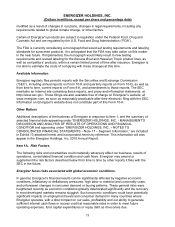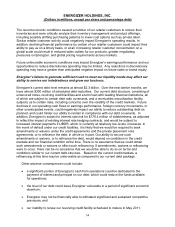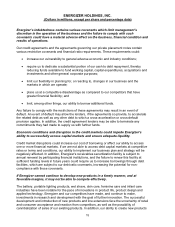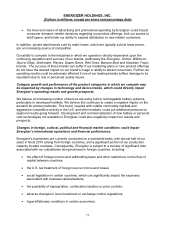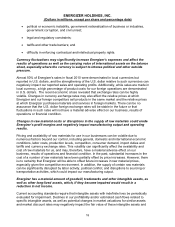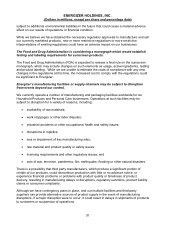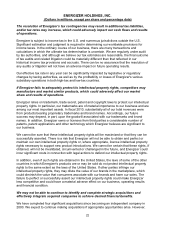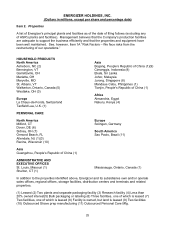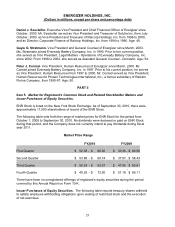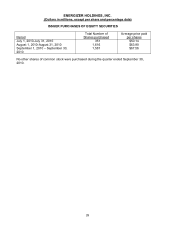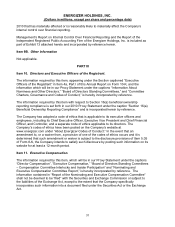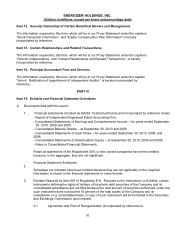Energizer 2010 Annual Report Download - page 33
Download and view the complete annual report
Please find page 33 of the 2010 Energizer annual report below. You can navigate through the pages in the report by either clicking on the pages listed below, or by using the keyword search tool below to find specific information within the annual report.
ENERGIZER HOLDINGS, INC.
(Dollars in millions, except per share and percentage data)
23
we may not be able to identify and successfully negotiate suitable strategic acquisitions, obtain
financing for future acquisitions on satisfactory terms or otherwise complete future acquisitions.
Furthermore, our existing operations may encounter unforeseen operating difficulties and may
require significant financial and managerial resources, which would otherwise be available for
the ongoing development or expansion of our existing operations.
Even if we can complete future acquisitions, we face significant challenges in consolidating
functions and effectively integrating procedures, personnel, product lines, and operations in a
timely and efficient manner. The integration process can be complex and time consuming, may
be disruptive to our existing and acquired businesses, and may cause an interruption of, or a
loss of momentum in, those businesses. Even if we can successfully complete the integration
of acquired businesses into our operations, there is no assurance that anticipated cost savings,
synergies, or revenue enhancements will be realized within the expected time frame, or at all.
The integration of Energizer’s and ASR’s businesses may not be successful or
anticipated benefits from the acquisition may not be realized.
The recent acquisition of ASR will require a significant amount of time and attention as well as
financial resources to the process of integrating the operations of Energizer’s business and
ASR’s business. We may be unable to integrate the ASR business into our operations in an
efficient, timely and effective manner.
All of the risks associated with the integration process could be exacerbated by the fact that we
may not have a sufficient number of employees with needed expertise to integrate the two
businesses or to operate the combined company’s business. Furthermore, ASR offers private
label products, a product group in which we have limited experience.
Even if we are able to successfully combine the two business operations, it may not be
possible to realize the full benefits of the increased sales volume and other benefits that are
currently expected to result from the acquisition, or realize these benefits within the time frame
that is currently expected. The benefits of the acquisition may also be offset by operating
losses relating to changes in commodity pricing, or in increased competition, or by risks and
uncertainties relating to the combined company’s private label and branded products. If we fail
to realize the benefits we anticipate from the acquisition, our results of operations may be
adversely affected.
We face risks arising from the restructuring of our operations.
In November 2010, we announced initiatives to restructure our Household Products business
with the intention of improving utilization and realizing cost savings in the future. The process
of restructuring could entail, among other activities, moving production between facilities,
closing facilities, reducing the level of staff, realigning our business processes and reorganizing
our overhead structure.
We continuously evaluate our operations and cost structure relative to general economic
conditions, market demands, cost competitiveness and our geographic footprint as it relates to
our production requirements. As a result of this ongoing evaluation, we initiated the
restructuring discussed above. See “Management’s Discussion and Analysis of Financial
Condition and Results of Operations — Recent Developments” included in Exhibit 13 attached
here to.


